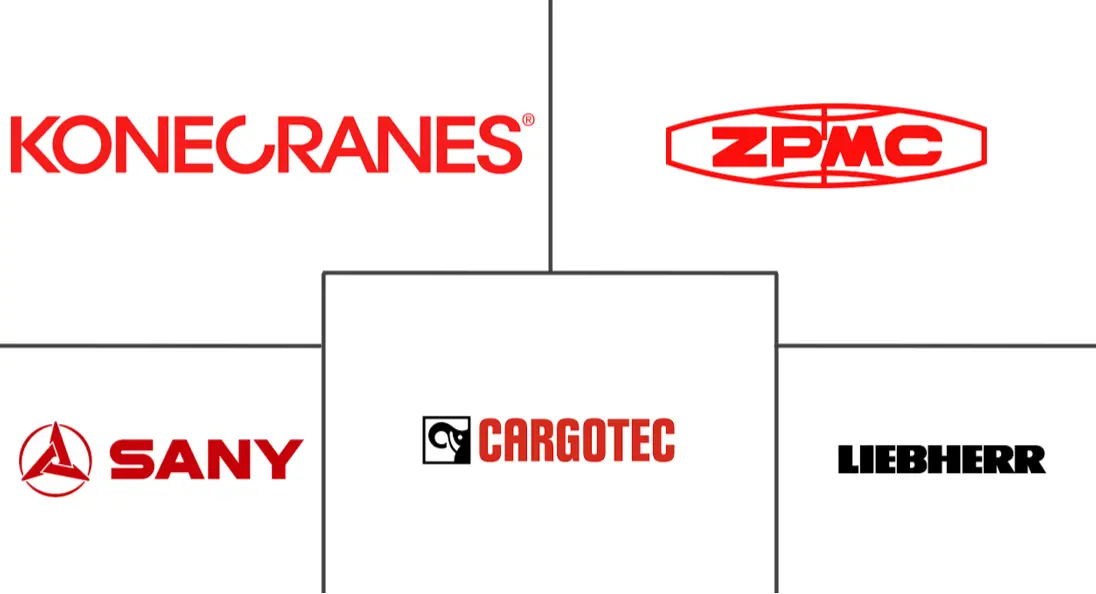Container Handling Equipment Market Size and Share
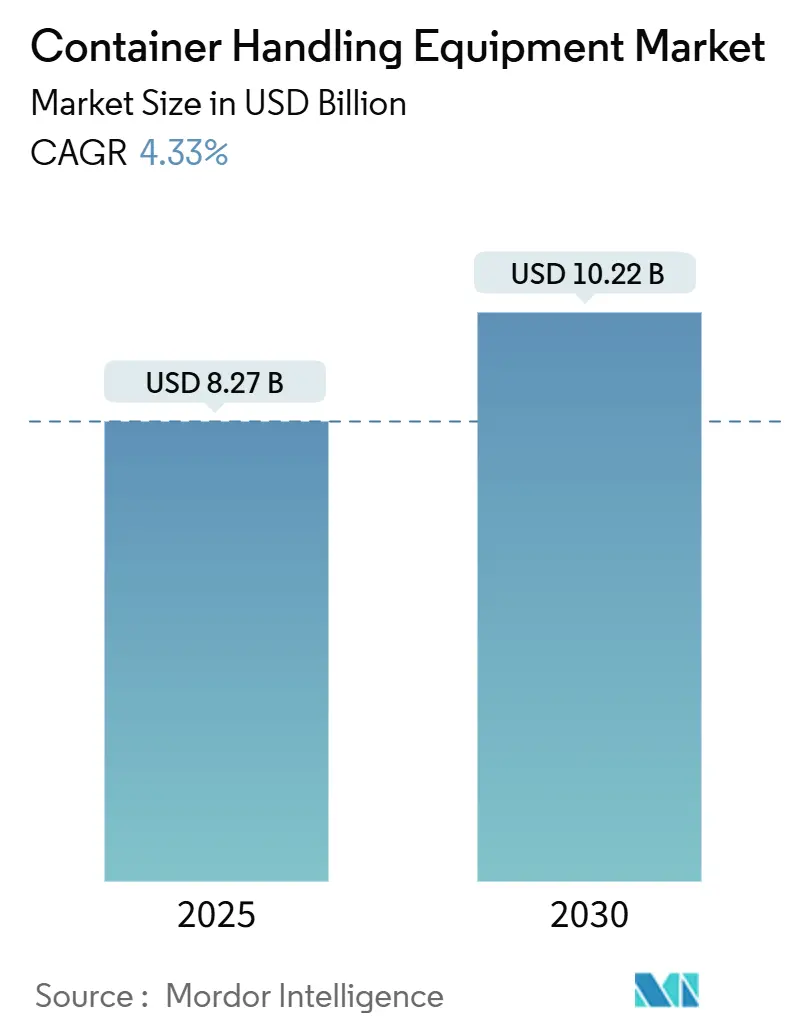
Container Handling Equipment Market Analysis by Mordor Intelligence
The Container Handling Equipment Market size is estimated at USD 8.27 billion in 2025, and is expected to reach USD 10.22 billion by 2030, at a CAGR of 4.33% during the forecast period (2025-2030). Rising electrification mandates, the sharp uptick in fully and semi-automated terminals, and persistent growth in global TEU throughput underpin this steady expansion of the container handling equipment market. Forklift trucks hold firm as the workhorse of the container handling equipment market. Yet, automated guided vehicles (AGVs) are reshaping long-term capex plans as terminals seek unmanned, round-the-clock operations.
Key Report Takeaways
- By equipment type, forklift trucks led with 36.13% of the container handling equipment market share in 2024, AGVs are set to expand at an 11.26% CAGR through 2030.
- By propulsion, diesel units retained 57.71% share of the container handling equipment market size in 2024, while battery-electric models are forecast to post an 18.52% CAGR to 2030.
- By automation level, manual fleets accounted for 47.83% of the container handling equipment market size in 2024, yet fully automated equipment will grow fastest at 22.31% CAGR.
- By end-user, seaport and river terminals captured 72.63% revenue share in 2024, and inland depots are the fastest-growing end-user segment at 9.44% CAGR.
- By geography, Asia-Pacific controlled 43.83% of the container handling equipment market share in 2024 and is expanding at a 7.81% CAGR.
Global Container Handling Equipment Market Trends and Insights
Drivers Impact Analysis
| Driver | (~) % Impact on CAGR Forecast | Geographic Relevance | Impact Timeline |
|---|---|---|---|
| Growing emphasis on electrification | +1.2% | Global, with early gains in California, Netherlands, Singapore | Medium term (2-4 years) |
| Automation and digitalization | +1.0% | North America and EU, selective APAC adoption | Medium term (2-4 years) |
| Port capacity expansion and rising global TEU | +0.8% | Asia-Pacific core, spill-over to MEA | Long term (≥ 4 years) |
| Modular high-capacity charging infrastructure | +0.6% | North America and EU coastal regions | Short term (≤ 2 years) |
| Hydrogen-ready handlers | +0.3% | Japan, Netherlands, California pilot sites | Long term (≥ 4 years) |
| Secondary market for refurbished electric reach-stackers | +0.2% | Global, with concentration in emerging markets | Medium term (2-4 years) |
| Source: Mordor Intelligence | |||
Growing Emphasis on Electrification of Container-Handling Fleets
Zero-emission rules are snowballing, led by California’s 2030 deadline and mirrored by EU Green Deal schedules. APM Terminals and DP World estimate present-day fleets emit 10–15 million tCO₂ annually, positioning fleet electrification as both a compliance necessity and an efficiency play.[1]APM Terminals, "Global Equipment Fleet Emissions White Paper,” apmterminals.com The Port of Los Angeles placed the first commercial electric top handlers into service in June 2024, logging 18-hour shifts on 1 MWh batteries while producing zero local emissions. Battery systems deliver 85–90% energy efficiency compared with hydrogen’s 40–50%, which translates into lower total cost of ownership despite higher up-front prices. Capital outlays are shrinking: APM Terminals allocated USD 47 million for 28 all-electric units at Brazil’s Suape terminal, operational in 2026, highlighting scale economies now coming into play. Nevertheless, limited OEM production capacity keeps delivery lead times tight, a fact that could temper near-term electrification momentum.
Automation and Digitalization of Terminal Operations
Global demand for autonomous cranes is expected to increase significantly by 2030, with Asia-Pacific absorbing over half of the demand. Qingdao’s fully automated terminal, running since 2023, has lifted throughput 15%, pushing crane productivity to 60.9 boxes per hour. Busan’s new automated terminal, launched in April 2024, registers up to 20% efficiency gains. APM Terminals' 71 new AGVs order for Rotterdam's Maasvlakte II terminal, expanding fleet to over 140 units by 2025, illustrates European terminals' aggressive automation scaling to double capacity by 2027.
Port Capacity Expansion and Rising Global TEU Throughput
Container throughput climbed to record levels in 2024, propelled by China’s Q1 double-digit gains and the New Western Land-Sea Corridor’s 20% volume jump at Guangxi ports. DP World surpassed the 100 million TEU capacity milestone in January 2025.[2]DP World, “DP World Surpasses 100 Million TEU Capacity,” dpworld.com Vessel deliveries remain brisk, with 478 ships (3.1 million TEU) hitting the water in 2024, up 41% year-on-year. India’s Sagarmala and Maritime Vision 2047 programmes are doubling capacity to beyond 3,300 MMT, demanding fresh fleets across crane, reach-stacker, and tractor categories. Growing yard congestion—four- to fourteen-day vessel queues at many ports - has forced operators to consider higher-capacity, automated systems to sustain service levels.
Modular High-Capacity Charging Infrastructure Speeds Electric Roll-Outs
Prologis and Performance Team’s 9 MW charging hub in Southern California, online since April 2024, showcases how a microgrid design can bypass constrained utility feeds and support 96 trucks simultaneously.[3]Prologis, “Prologis/Performance Team EV Depot Fact Sheet,” prologis.com Germany’s EUROGATE rolled out private 5G networks in early 2024 to coordinate automated fleets and charge scheduling. Policy support accelerates the trend: the US Clean Ports Project earmarked USD 3 billion for equipment upgrades, while National Grid’s UK forecast warns that ports must triple their electricity supply by 2050. By eliminating grid-upgrade bottlenecks, modular charging reduces CAPEX hurdles and quickens decision cycles for smaller terminals.
Restraints Impact Analysis
| Restraint | (~) % Impact on CAGR Forecast | Geographic Relevance | Impact Timeline |
|---|---|---|---|
| High capital cost and long pay-back periods | -0.9% | Global, acute in emerging markets | Medium term (2-4 years) |
| Supply-chain lead-time volatility | -0.6% | Global, with concentration in Asia-Pacific manufacturing | Short term (≤ 2 years) |
| Grid-capacity bottlenecks | -0.4% | North America & EU legacy infrastructure | Medium term (2-4 years) |
| System-integration complexity | -0.3% | Global, particularly acute in established terminals | Long term (≥ 4 years) |
| Source: Mordor Intelligence | |||
High Capital Cost and Long Pay-Back Periods
Electric reach-stackers cost USD 1.7 million per unit, nearly double the price of diesel counterparts. AGV contracts routinely stretch into nine-figure territory; for instance, Konecranes’ 71-unit AGV delivery to Rotterdam commands a multiyear, multimillion-dollar budget. Small operators face credit-rating hurdles, and payback periods of 7 - 10 years deter quick adoption in emerging markets where the cost of capital is higher. Booking softness has emerged: Hyster-Yale reported a 56% drop in North America orders during Q4 2024, underscoring buyer caution amid economic uncertainty.
Supply-Chain Lead-Time Volatility for Critical Components
The 2024 Red Sea crisis and Panama Canal drought extended average parts lead times by 30%. Proposed 100% US tariffs on Chinese cranes risk deeper disruption; ZPMC supplies a major share of ship-to-shore units, and any import freeze could impair quay operations at dozens of ports. Semiconductor shortfalls linger, pushing delivery of advanced control systems to 12–18 months. Many terminals now stock larger spares inventories and spread orders among alternate suppliers where feasible, locking in contingency costs that weigh directly on margins.
Segment Analysis
By Equipment Type: Forklift Dominance Meets AGV Innovation
Forklift trucks generated 36.13% of the container handling equipment market revenue in 2024, cementing their status as the backbone of day-to-day yard work. The container handling equipment market size for forklifts is forecast to expand modestly as replacement cycles shift toward electric variants, whereas AGVs, from a smaller base, are pegged for an 11.26% CAGR through 2030.
Historical data reveal that, despite pandemic-era restrictions, demand for traditional diesel forklifts remained resilient, supported by rapid e-commerce fulfilment growth. Yet since 2022, AGV adoption has accelerated in automation-ready terminals seeking labour-cost insulation and 24-hour throughput consistency. Kalmar’s E-VER electric forklift line and Konecranes’ modular Noell straddle carriers—offered in hybrid, battery, and hydrogen versions—signal an OEM pivot toward full-line electrified portfolios. In China, more than 300 AGVs operate across Qingdao, Nansha, and Xiamen ports, proving scalability and giving Asian vendors a playbook that global operators are now studying closely to retain competitiveness in the container handling equipment market.
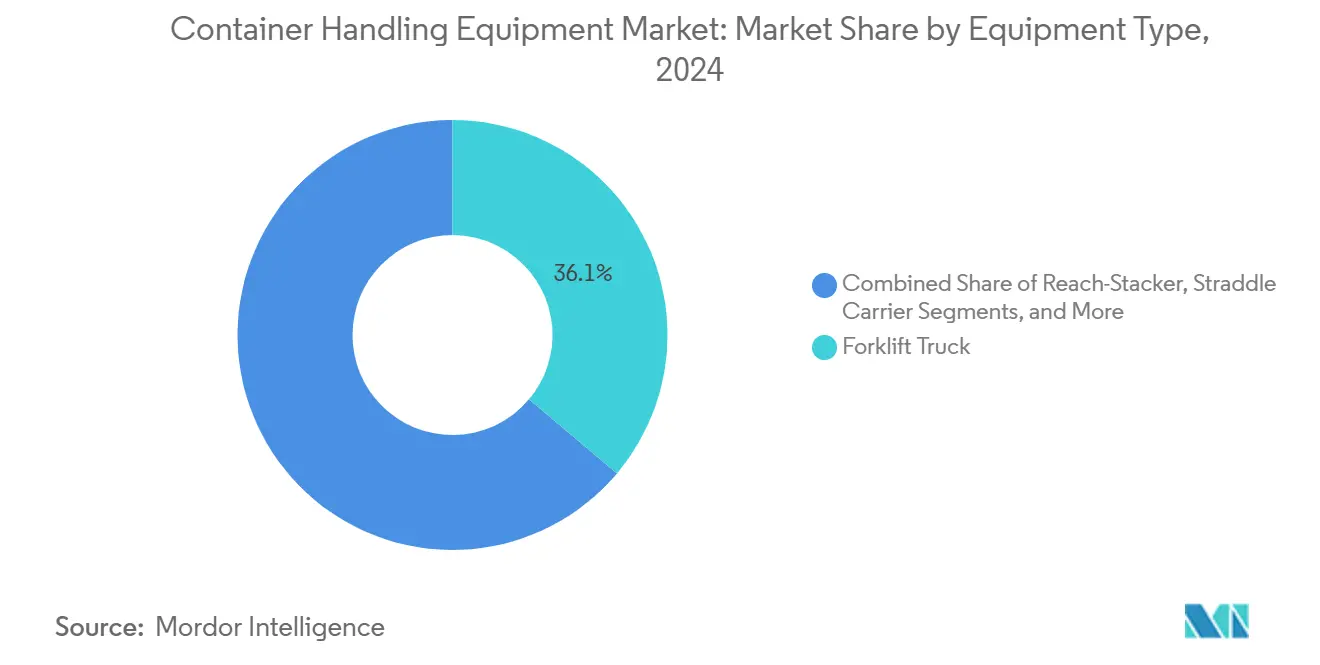
Note: Segment shares of all individual segments available upon report purchase
By Propulsion Type: Diesel Persistence Amid Electric Acceleration
Diesel still dominates 57.71% of the container handling equipment market in 2024, reflecting the sheer size of the installed base and the global ubiquity of refuelling infrastructure. Battery electric equipment is the fastest riser at an 18.52% CAGR and is projected to command close to one-quarter of new sales by 2030, supported by falling battery prices and policy carrots. Hydrogen fuel cell units occupy a niche 4.6% slice. Yet, landmark deployments - such as the Mitsui E&S/PACECO zero-emission RTG crane at the Port of Los Angeles - demonstrate the technology’s viability in power-dense applications.
During 2019 - 2024, the diesel fleet’s share eroded gradually as regional mandates hardened. California’s zero-emission rule alone could transition 12,000 machines by 2030, while the EU’s Fit-for-55 raises carbon pricing pressure on every litre of bunker fuel consumed inside port gates. OEMs now comply with Stage V or Tier 4 Final diesel emission norms but simultaneously launch electric options across nearly every SKU. The Zero Emission Port Alliance projects that 94% of new purchases among member terminals will be battery electric by 2035, a milestone that would redraw propulsion-mix charts in the container handling equipment market.
By Automation Level: Manual Operations Yielding to Full Automation
Manual fleets comprised 47.83% of the container handling equipment market size in 2024, driven by ongoing reliance on human-operated forklifts and yard tractors in smaller ports. Semi-automated systems - where yard cranes or stacking machines run on remote or automated modes while vehicles remain manually driven. Fully automated solutions, including AGVs, autonomous cranes, and driverless yard trucks, are scaling swiftly at 22.31% CAGR.
China’s 52 automated terminals processed roughly 300 million containers in 2024, proving fully automated layouts can handle extreme throughput. Europe’s semi-automation model aims to balance social acceptability with productivity gains; Hutchison Ports BEST in Spain added seven new automated blocks in early 2025, lifting storage capacity 25% without triggering workforce friction. North American facilities face union constraints, limiting full automation to greenfield projects such as Long Beach’s Pier T. Nonetheless, even conservative operators now deploy advanced telemetry, collision avoidance, and predictive-maintenance software on manual fleets, blurring the lines between automation classes while improving asset-turnover ratios in the container handling equipment market.
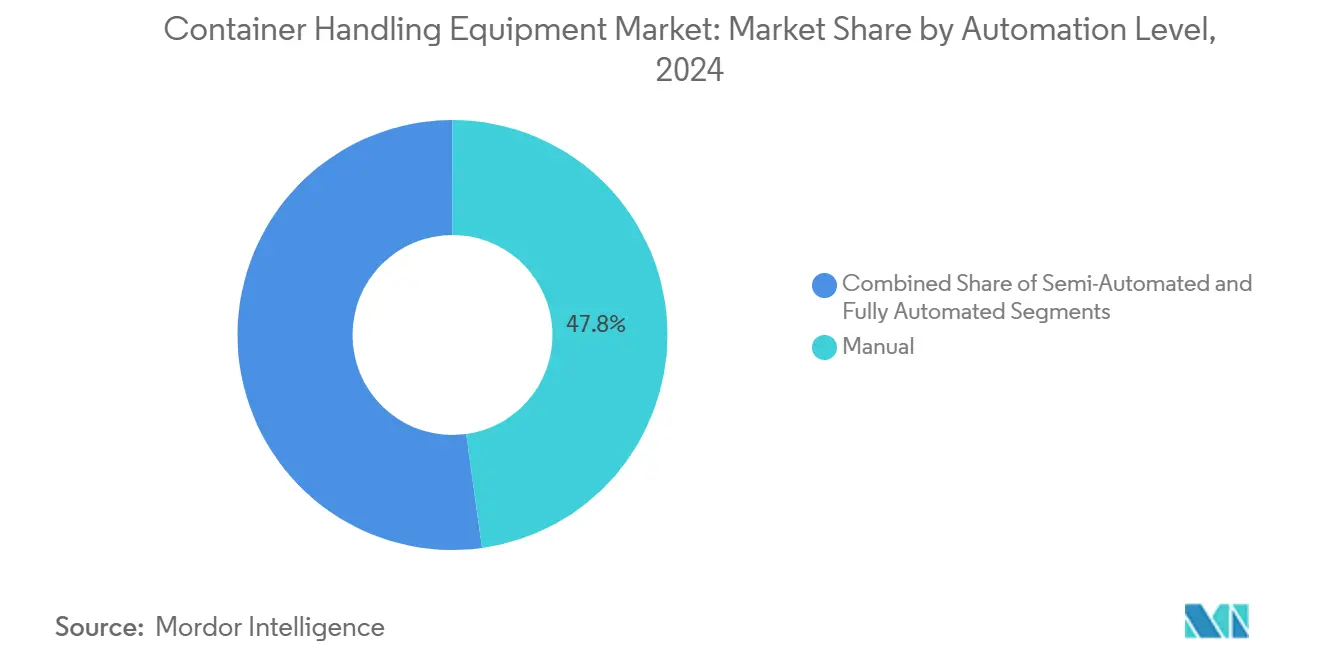
Note: Segment shares of all individual segments available upon report purchase
By End-User: Seaport Dominance with Inland Depot Growth
Seaport and river terminals anchored 72.63% of revenue in 2024. Inland container depots (ICDs) are projected to expand at a 9.44% CAGR as supply chains decentralise. Container freight stations and warehouses benefit from the rise of cross-docking and urban distribution centres.
Seaports continue to command the bulk of CAPEX: DP World earmarked USD 3 billion for African expansions by 2029, while Saudi Arabia’s NEOM port is installing fully automated cranes ahead of a 2026 start-up. Still, inland nodes are on the ascendancy. India’s dedicated freight corridors and multimodal logistics parks have triggered equipment demand deeper inland, improving hinterland connectivity and relieving coastal congestion. Latin America offers a case in point: APM Terminals’ all-electric Suape facility, operational in 2026, showcases how ICDs can leapfrog directly to zero-emission fleets. The resulting geographic diversification sharpens demand granularity and calls for a broader specification range from OEMs in the container handling equipment market.
Geography Analysis
Asia-Pacific retained a hefty 43.83% share in 2024, buoyed by China’s automated terminal build-out and India’s Maritime Vision 2047 investment drive. Regional CAGR stands fastest at 7.81%. China’s automated throughput of 300 million containers underscores its first-mover advantage; India, meanwhile, grew cargo handling from 871 MMT in 2015 to 1,617 MMT in 2023 and is targeting 3,300 MMT by the end of this decade. Japan’s hydrogen pilot projects and South Korea’s Busan automation success stories further anchor regional leadership. Supply-chain tension remains a watchpoint, however, as potential US tariffs on Chinese cranes could reverberate through APAC manufacturing networks.
Europe accounted for the second largest share and is expanding at a robust CAGR. The continent’s focus is transitioning from scale to sustainability. APM Terminals Rotterdam will field 140 AGVs by 2025, and EUROGATE’s 5G roll-outs provide a technology backbone for fleet electrification and predictive maintenance. The Netherlands is emerging as an early adopter of battery-electric reach-stackers, aided by Konecranes’ acquisition of Peinemann Port Services. The region is in replacement rather than greenfield mode, yet strict emissions codes keep demand steady for low- and zero-emission equipment.
North America held one fifth of the market share in 2024. California’s zero-emission schedule and the EPA’s USD 3 billion Clean Ports Project catalyse fleet renewals. The Port of Los Angeles introduced electric top handlers in mid-2024, and a 9 MW private charging depot proves high-power infrastructure feasibility. Labour considerations slow full automation; instead, hybrid operating models combine remote crane operations with conventional trucking. Middle East and Africa’s 8.4% share is buttressed by mega-projects such as NEOM and DP World’s continental investments. South America’s share benefits from Suape’s forthcoming all-electric terminal, signaling a pivot toward greener equipment in emerging markets. Collectively, these regional trends reinforce a steady but differentiated growth map for the container handling equipment market.
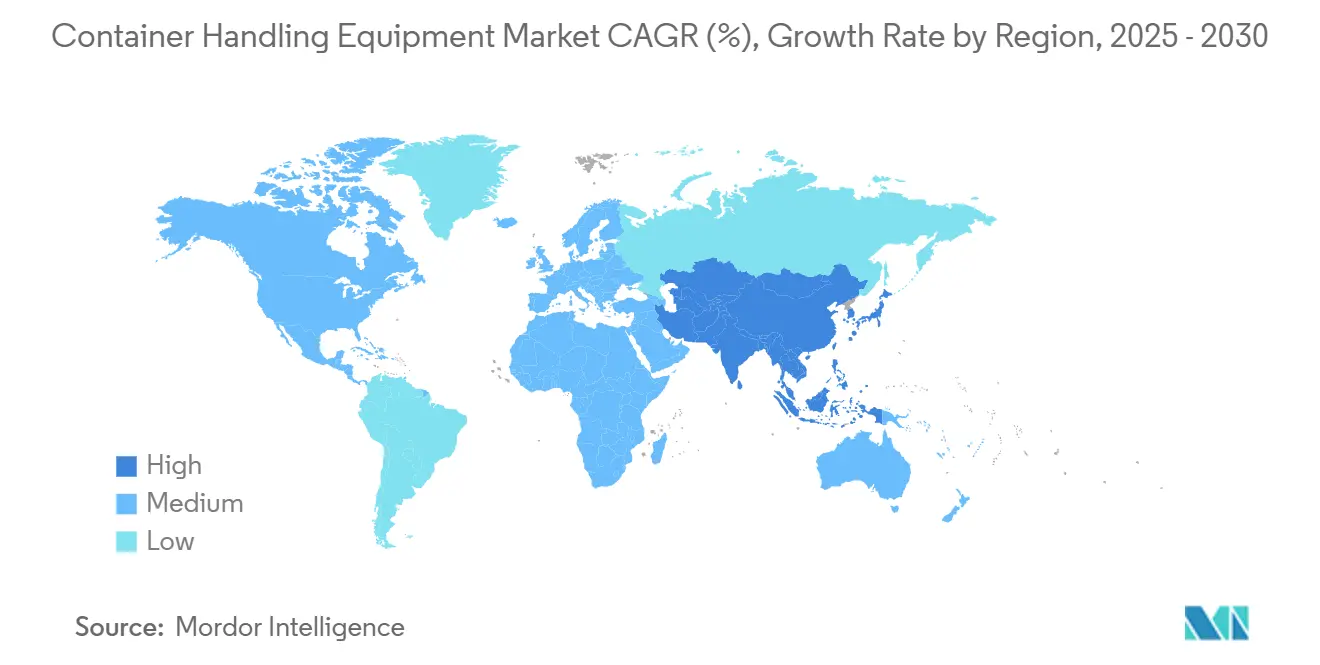
Competitive Landscape
Competition is moderately concentrated. Market leaders Cargotec (Kalmar), Konecranes, and Shanghai ZPMC together capture a mid-teen slice of global revenues, with the remainder fragmented among Terex, Hyster-Yale, SANY, and a clutch of automation start-ups. Cargotec’s 2024 restructuring - demerging Kalmar and divesting MacGregor to Triton - tightens its focus on core container handling solutions. Konecranes posted a record 14.3% EBITA margin in H1 2024 and accelerated its electrification roadmap by acquiring Peinemann Port Services, adding retrofit and service depth in Europe’s busiest port.
Innovation patterns show incumbents embracing AI and data platforms. KION Group joined forces with NVIDIA and Accenture to pilot digital-twin yard orchestration that could squeeze 6–8% extra crane moves per hour. OEM-agnostic software houses have emerged, monetising predictive analytics via subscription, reducing reliance on razor-thin hardware margins. Tariff risk is reshaping sourcing strategies: ZPMC faces headwinds in the US and parts of Europe, prompting ports to dual-source from South Korean and European yards. At the same time, SANY’s revenue jumped 66.7% in Africa during H1 2024 compared to H1 2023, which demonstrates that regional players can quickly step into supply gaps.
Several players are exploring service-based revenue, offering equipment-as-a-service contracts that bundle maintenance, software, and battery leasing. This model appeals to mid-size terminals keen to conserve capex. Outrider’s USD 62 million Series D to commercialise autonomous yard tractors exemplifies how venture-backed newcomers target niche pain points inside the container handling equipment market, forcing established suppliers to accelerate their own autonomy roll-outs or risk share erosion.
Container Handling Equipment Industry Leaders
-
SANY Group
-
Liebherr Group
-
Konecranes
-
Cargotec Corporation
-
Shanghai ZPMC
- *Disclaimer: Major Players sorted in no particular order
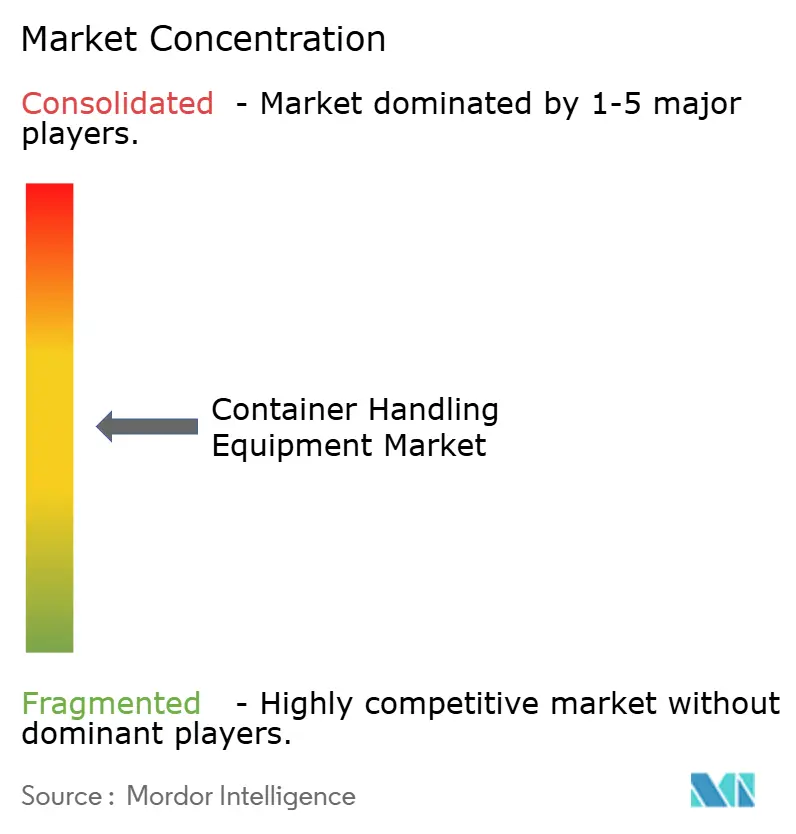
Recent Industry Developments
- December 2024: Hyster-Yale confirmed full compliance with Build America, Buy America rules for electric container handlers, unlocking access to federal funding channels.
- December 2024: Konecranes completed the acquisition of Peinemann Port Services in Rotterdam for over EUR 40 million, bolstering its Port Solutions division.
- October 2024: APM Terminals ordered 71 AGVs from Konecranes for Rotterdam’s Maasvlakte II, enlarging the fleet to more than 140 units by 2025.
- May 2024: Mitsui E&S and PACECO launched the world’s first hydrogen fuel-cell RTG crane at the Port of Los Angeles.
Research Methodology Framework and Report Scope
Market Definitions and Key Coverage
Our study defines the container handling equipment market as the global sales value of purpose-built machines, such as reach stackers, straddle carriers, rubber-tired gantry cranes, ship-to-shore cranes, terminal tractors, automated guided vehicles, and heavy forklifts, that move ISO freight containers within seaports, river terminals, rail yards, inland depots, and large warehouses. These units are counted the year they are factory-built and first delivered into service, regardless of leasing model or geographic destination.
Scope exclusion: software and standalone automation systems that do not ship with physical lifting hardware are outside the market.
Segmentation Overview
- By Equipment Type
- Forklift Truck
- Reach Stacker
- Straddle Carrier
- Rubber Tired Gantry Crane
- Ship-to-Shore Crane
- Automated Guided Vehicle (AGV)
- Terminal Tractor/Yard Truck
- By Propulsion Type
- Diesel
- Hybrid
- Battery Electric
- Hydrogen Fuel Cell
- Others (Gasoline, LPG, etc.)
- By Automation Level
- Manual
- Semi-Automated
- Fully Automated
- By End-User
- Seaport and River Terminals
- Inland Container Depots/Rail Yards
- Container Freight Stations and Warehouses
- By Geography
- North America
- United States
- Canada
- Rest of North America
- South America
- Brazil
- Argentina
- Rest of South America
- Europe
- Germany
- United Kingdom
- France
- Italy
- Spain
- Netherlands
- Russia
- Rest of Europe
- Asia-Pacific
- China
- India
- Japan
- South Korea
- Australia
- Rest of Asia-Pacific
- Middle East and Africa
- Turkey
- Saudi Arabia
- United Arab Emirates
- South Africa
- Egypt
- Rest of Middle East and Africa
- North America
Detailed Research Methodology and Data Validation
Primary Research
Mordor analysts interviewed port engineering heads, equipment procurement managers, finance controllers at leading OEMs, and yard automation specialists across Asia-Pacific, Europe, North America, and the Gulf. These dialogues clarified renewal triggers, emerging hydrogen trials, and realistic automation pay-back periods, which we then used to tighten model assumptions and stress-test early desk findings.
Desk Research
We began by mapping the installed base, replacement cycles, and new-build deliveries using open datasets from bodies such as UNCTAD, the International Association of Ports and Harbors, and the World Bank's maritime trade indicators. National customs logs, port authority throughput dashboards, and equipment certification lists added fine-grained shipment clues, while energy transition road maps from the International Energy Agency informed propulsion splits. Company 10-Ks, investor decks, and equipment testing certificates were mined through Dow Jones Factiva and D&B Hoovers to anchor average selling prices and OEM revenue mix. The United States EPA, the European Environment Agency, and China's MIIT offered regulatory timelines that guided our drivetrain forecast. The sources cited above are illustrative; many additional public and paid references fed the desk study matrix.
Market-Sizing & Forecasting
A top-down demand pool was first built by correlating global loaded-container throughput, average container moves per new machine, and fleet renewal ratios. Results were checked with selective bottom-up roll-ups of sampled OEM shipments multiplied by region-specific ASPs to tune currency effects and niche equipment premiums. Key variables include global TEU growth, port capex intensity, average power train cost deltas, terminal automation penetration, diesel-to-electric price spreads, and fleet age distribution. Forecasts use a multivariate regression that links equipment demand to TEU volume, port capex indices, and an electrification index, after which three scenario layers adjust for trade elasticity shocks. Data gaps in sampled ASPs are bridged through weighted regional proxies validated during primary calls.
Data Validation & Update Cycle
Before sign-off, model outputs undergo variance checks against historical sales curves, import-export anomalies, and capital equipment price indices. Senior analysts review the workbook and trigger re-contacts when deviations breach preset bands. We refresh every twelve months and issue interim patches if sizable regulatory or trade events occur.
Why Mordor's Container Handling Equipment Baseline Commands Reliability
Published numbers often diverge because firms select different equipment sets, apply varied ASP progression rules, or freeze exchange rates at dissimilar points. We disclose each filter and update cadence, allowing buyers to trace every step.
Key gap drivers arise when others omit inland depots, mix broader material handling categories, apply single global prices, or project aggressive automation uptake without validating capital budgets.
Benchmark comparison
| Market Size | Anonymized source | Primary gap driver |
|---|---|---|
| USD 8.27 B (2025) | Mordor Intelligence | - |
| USD 8.03 B (2024) | Global Consultancy A | Excludes yard tractors and hydrogen units, relies on TEU proxy with minimal ASP nuance |
| USD 7.99 B (2024) | Trade Journal B | Counts only seaport terminals, omits inland depots and rail yards |
| USD 8.75 B (2025) | Industry Association C | Blends cranes with generic material handling gear and applies a flat global ASP |
The comparison shows that once scope, equipment mix, and pricing logic are aligned, our figure sits mid-range and therefore offers a balanced anchor. Clients can depend on Mordor's disciplined source mix, transparent filters, and annual refresh cycle for decisions that withstand board-level scrutiny.
Key Questions Answered in the Report
What is the current size of the container handling equipment market?
The market stands at USD 8.27 billion in 2025 and is expected to grow at a 4.31% CAGR through 2030.
Which equipment type leads sales today?
Forklift trucks hold 36.13% of container handling equipment market share, keeping them the top revenue generator.
How fast are battery-electric units gaining ground?
Battery-electric equipment is expanding at a robust CAGR from a strong share base, signaling rapid acceleration.
Which region is growing the fastest?
Asia-Pacific posts the strongest growth at 7.81% CAGR due to China’s automation leadership and India’s port expansion.
What is the biggest restraint facing electrification?
High upfront costs, with electric reach-stackers priced around USD 1.7 million apiece and payback periods exceeding seven years.
Are fully automated terminals becoming mainstream?
Fully automated equipment still accounts for nearly one fifth of fleet value but is scaling at a robust CAGR, indicating a clear upward trajectory.
Page last updated on:
